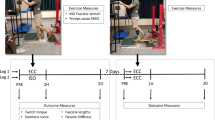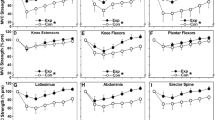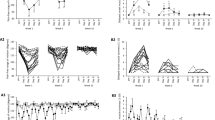Abstract
Electrical stimulation (ES) induces muscle damage that is characterised by histological alterations of muscle fibres and connective tissue, increases in circulating creatine kinase (CK) activity, decreases in muscle strength and development of delayed onset muscle soreness (DOMS). Muscle damage is induced not only by eccentric contractions with ES but also by isometric contractions evoked by ES. Muscle damage profile following 40 isometric contractions of the knee extensors is similar between pulsed current (75 Hz, 400 μs) and alternating current (2.5 kHz delivered at 75 Hz, 400 μs) ES for similar force output. When comparing maximal voluntary and ES-evoked (75 Hz, 200 μs) 50 isometric contractions of the elbow flexors, ES results in greater decreases in maximal voluntary contraction strength, increases in plasma CK activity and DOMS. It appears that the magnitude of muscle damage induced by ES-evoked isometric contractions is comparable to that induced by maximal voluntary eccentric contractions, although the volume of affected muscles in ES is not as large as that of eccentric exercise-induced muscle damage. It seems likely that the muscle damage in ES is associated with high mechanical stress on the activated muscle fibres due to the specificity of motor unit recruitment (i.e., non-selective, synchronous and spatially fixed manner). The magnitude of muscle damage induced by ES is significantly reduced when the second ES bout is performed 2–4 weeks later. It is possible to attenuate the magnitude of muscle damage by “pre-conditioning” muscles, so that muscle damage should not limit the use of ES in training and rehabilitation.






Similar content being viewed by others
References
Aldayel A, Jubeau M, McGuigan MR, Nosaka K (2010a) Less indication of muscle damage in the second than initial electrical muscle stimulation bout consisting of isometric contractions of the knee extensors. Eur J Appl Physiol 108:709–717
Aldayel A, Jubeau M, McGuigan MR, Nosaka K (2010b) Comparison between alternating and pulsed current electrical muscle stimulation for acute muscle and systemic responses. J Appl Physiol 109:735–744
Armstrong RB (1990) Initial events in exercise-induced muscular injury. Med Sci Sports Exerc 22:429–435
Black CD, McCully KK (2008a) Force per active area and muscle injury during electrically stimulated contractions. Med Sci Sports Exerc 40:1605–1615
Black CD, McCully KK (2008b) Muscle injury after repeated bouts of voluntary and electrically stimulated exercise. Med Sci Sports Exerc 40:1605–1615
Brooks SV, Faulkner JA (1996) The magnitude of the initial injury induced by stretches of maximally activated muscle fibres of mice and rats increases in old age. J Physiol 497:573–580
Chapman DW, Newton M, McGuigan MR, Nosaka K (2008) Comparison between old and young men for responses to fast velocity maximal lengthening contractions of the elbow flexors. Eur J Appl Physiol 104:531–539
Chen TC, Nosaka K, Sacco P (2007) Intensity of initial eccentric exercise and the magnitude of repeated bout effect. J Appl Physiol 102:992–999
Chen TC, Lin KY, Chen HL, Lin MJ, Nosaka K (2011) Comparison in eccentric exercise-induced muscle damage among four limb muscles. Eur J Appl Physiol 111:211–223
Cheung K, Hume PA, Maxwell L (2003) Delayed onset muscle soreness: treatment strategies and performance factors. Sports Med 33:145–164
Clarkson PM, Nosaka K, Braun B (1992) Muscle function after exercise-induced muscle damage and rapid adaptation. Med Sci Sports Exerc 24:512–520
Crameri RM, Aagaard P, Qvortrup K, Langberg H, Olesen J, Kjaer M (2007) Myofibre damage in human skeletal muscle: effects of electrical stimulation versus voluntary contraction. J Physiol 583:365–380
Dartnall TJ, Nordstrom MA, Semmler JG (2008) Motor unit synchronization is increased in biceps brachii after exercise-induced damage to elbow flexor muscles. J Neurophysiol 99:1008–1019
Dartnall TJ, Rogasch NC, Nordstrom MA, Semmler JG (2009) Eccentric muscle damage has variable effects on motor unit recruitment thresholds and discharge patterns in elbow flexor muscles. J Neurophysiol 102:413–423
Foley JM, Jayaraman RC, Prior BM, Pivarnik JM, Meyer RA (1999) MR measurements of muscle damage and adaptation after eccentric exercise. J Appl Physiol 87:2311–2318
Fridén J, Lieber RL (2001) Eccentric exercise-induced injuries to contractile and cytoskeletal muscle fibre components. Acta Physiol Scand 171:321–326
Gibala MJ, MacDougall JD, Stauber WT, Elorriaga A (1995) Changes in human skeletal muscle ultrastructure and force production after acute resistance exercise. J Appl Physiol 78:702–708
Gregory CM, Bickel CS (2005) Recruitment patterns in human skeletal muscle during electrical stimulation. Phys Ther 85:358–364
Guarascio P, Lusi EA, Soccorsi F (2004) Electronic muscular stimulator: a novel unsuspected cause of rhabdomyolysis. Br J Sports Med 38:505–507
Hansen M, Trappe T, Crameri RM, Qvortrup K, Kjaer M, Langberg H (2009) Myofibrillar proteolysis in response to voluntary or electrically stimulated muscle contractions in humans. Scan J Med Sci Sports 19:75–82
Hedayatpour N, Falla D, Arendt-Nielsen L, Vila-Cha C, Farina D (2009) Motor unit conduction velocity during sustained contraction after eccentric exercise. Med Sci Sports Exerc 41:1927–1933
Hortobágyi T, Houmard J, Fraser D, Dudek R, Lambert J, Tracy J (1998) Normal forces and myofibrillar disruption after repeated eccentric exercise. J Appl Physiol 84:492–498
Howell JN, Chleboun G, Conatser R (1993) Muscle stiffness, strength loss, swelling and soreness following exercise-induced injury in humans. J Physiol 464:183–196
Ingalls CP, Wenke JC, Nofal T, Armstrong RB (2004) Adaptation to lengthening contraction-induced injury in mouse muscle. J Appl Physiol 97:1067–1076
Jubeau M, Sartorio A, Marinone PG, Agosti F, Van Hoecke J, Nosaka K, Maffiuletti NA (2008) Comparison between voluntary and stimulated contractions of the quadriceps femoris for growth hormone response and muscle damage. J Appl Physiol 104:75–81
Jubeau M, Muthalib M, Millet GY, Maffiuletti NA, Nosaka K (2011) Comparison in muscle damage between maximal voluntary and electrically evoked isometric contractions of the elbow flexors. Eur J Appl Physiol [Epub ahead of print]
Lake DA (1992) Neuromuscular electrical stimulation. An overview and its application in the treatment of sports injuries. Sports Med 13:320–336
Lau WY, Nosaka K (2011) Effect of vibration treatment on symptoms associated with eccentric exercise-induced muscle damage. Am J Phys Med Rehabil 90(8):648–657
Lauritzen F, Paulsen G, Raastad T, Bergersen LH, Owe SG (2009) Gross structural changes and necrotic fiber segments in elbow flexor muscles after maximal voluntary eccentric action in humans. J Apply Physiol 107:1923–1934
Lavender AP, Nosaka K (2008) A light load eccentric exercise confers protection against a subsequent bout of more demanding eccentric exercise. J Sci Med Sport 11:291–298
Mackey AL, Bojsen-Moller J, Qvortrup K, Langberg H, Suetta C, Kalliokoski KK, Kjaer M, Magnusson SP (2008) Evidence of skeletal muscle damage following electrically stimulated isometric muscle contractions in humans. J Appl Physiol 105:1620–1627
Mackey AL, Brandstetter S, Schjerling P, Bojsen-Moller J, Qvortrup K, Pedersen MM, Doessing S, Kjaer M, Magnusson SP, Langberg H (2011) Sequenced response of extracellular matrix deadhesion and fibrotic regulators after muscle damage in involved in protection against future injury in human skeletal muscle. FASEB J 25(6):1943–1959
Maffiuletti NA (2010) Physiological and methodological considerations for the use of neuromuscular electrical stimulation. Eur J Appl Physiol 110:223–234
McHugh MP (2003) Recent advances in the understanding of the repeated bout effect: the protective effect against muscle damage from a single bout of eccentric exercise. Scand J Med Sci Sports 13:88–97
Moreau D, Dubots P, Boggio V, Guilland JC, Cometti G (1995) Effects of electromyostimulation and strength training on muscle soreness, muscle damage and sympathetic activation. J Sports Sci 13:95–100
Morton JP, Kayani AC, McArdle A, Drust B (2009) The exercise-induced stress response of skeletal muscle, with specific emphasis on humans. Sports Med 39:643–662
Newton MJ, Morgan GT, Sacco P, Chapman DW, Nosaka K (2008) Comparison of responses to strenuous eccentric exercise of the elbow flexors between resistance-trained and untrained men. J Strength Cond Res 22:597–607
Nosaka K (2008) Muscle soreness, muscle damage and repeated bout effect. In: Tiidus PM (ed) Muscle damage and repair. Human Kinetics, Champaign, pp 59–76
Nosaka K (2009) Muscle damage and adaptation induced by lengthening contractions. In: Shinohara M (ed) Advances in neuromuscular physiology of motor skills and muscle fatigue. Research Signpost. Kerala, India, pp 415–435
Nosaka K (2011) Exercise-induced muscle damage and delayed onset muscle soreness. In: Cardinale M, Newton R, Nosaka K (eds) Strength and conditioning: biological principals and practical applications. Wiley-Blackwell, Chicester, pp 179–192
Nosaka K, Clarkson PM (1996) Changes in indicators of inflammation after eccentric exercise of the elbow flexors. Med Sci Sports Exerc 28:953–961
Nosaka K, Sakamoto K (2001) Effect of elbow joint angle on the magnitude of muscle damage to the elbow flexors. Med Sci Sports Exerc 33:22–29
Nosaka K, Newton M, Sacco P (2002a) Responses of human elbow flexor muscles to electrically stimulated forced lengthening exercise. Acta Physiol Scand 174:137–145
Nosaka K, Newton M, Sacco P (2002b) DOMS does not reflect the magnitude of eccentric exercise-induced muscle damage. Scand J Med Sci Sports 12:337–346
Peake J, Nosaka K, Suzuki K (2005) Characterization of inflammatory responses to eccentric exercise in humans. Exerc Immunol Rev 11:64–85
Philippou A, Maridaki M, Bogdanis GC (2003) Angle-specific impairment of elbow flexors strength after isometric exercise at long muscle length. J Sports Sci 21:859–865
Powers SK, Jackson MJ (2008) Exercise-induced oxidative stress: cellular mechanisms and impact on muscle force production. Physiol Rev 88:1243–1276
Raastad T, Owe SG, Paulsen G, Enns D, Overgaard K, Crameri R, Kiil S, Belcastro A, Bergersen L, Hallén J (2010) Changes in calpain activity, muscle structure, and function after eccentric exercise. Med Sci Sports Exerc 42:86–95
Stauber WT, Smith CA (1998) Cellular responses in exertion-induced skeletal muscle injury. Mol Cell Biochem 179:189–196
Warren GL, Lowe DA, Armstrong RB (1999) Measurement tools used in the study of eccentric contraction-induced injury. Sports Med 27:43–59
Zorn C, Szekeres T, Keilani M, Fialka-Moser V, Crevenna R (2007) Effects of neuromuscular electrical stimulation of the knee extensor muscles on muscle soreness and different serum parameters in young male athletes: preliminary data. Br J Sports Med 41:914–916
Author information
Authors and Affiliations
Corresponding author
Additional information
Communicated by Roberto Bottinelli.
This article is published as part of the Special Issue Cluster on the XVIII Congress of the International Society of Electrophysiology and Kinesiology (ISEK 2010) that took place in Aalborg, Denmark on 16–19 June 2010.
Rights and permissions
About this article
Cite this article
Nosaka, K., Aldayel, A., Jubeau, M. et al. Muscle damage induced by electrical stimulation. Eur J Appl Physiol 111, 2427–2437 (2011). https://doi.org/10.1007/s00421-011-2086-x
Received:
Accepted:
Published:
Issue Date:
DOI: https://doi.org/10.1007/s00421-011-2086-x




